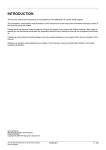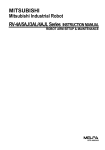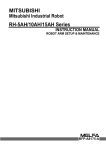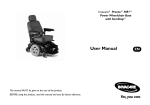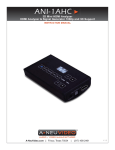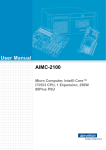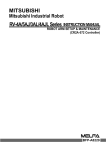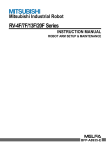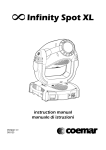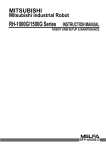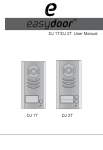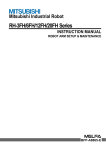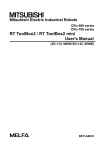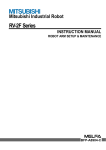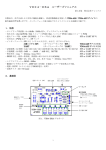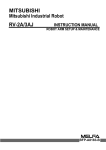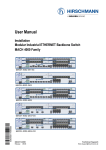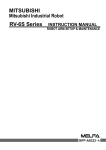Download MITSUBISHI RP-1AH/3AH/5AH Series INSTRUCTION MANUAL
Transcript
MITSUBISHI Mitsubishi Industrial Robot RP-1AH/3AH/5AH Series INSTRUCTION MANUAL ROBOT ARM SETUP & MAINTENANCE BFP-A8111-C Safety Precautions Always read the following precautions and the separate "Safety Manual" before starting use of the robot to learn the required measures to be taken. CAUTION CAUTION WARNING CAUTION WARNING CAUTION CAUTION CAUTION All teaching work must be carried out by an operator who has received special training. (This also applies to maintenance work with the power source turned ON.) → Enforcement of safety training For teaching work, prepare a work plan related to the methods and procedures of operating the robot, and to the measures to be taken when an error occurs or when restarting. Carry out work following this plan. (This also applies to maintenance work with the power source turned ON.) → Preparation of work plan Prepare a device that allows operation to be stopped immediately during teaching work. (This also applies to maintenance work with the power source turned ON.) → Setting of emergency stop switch During teaching work, place a sign indicating that teaching work is in progress on the start switch, etc. (This also applies to maintenance work with the power source turned ON.) → Indication of teaching work in progress Provide a fence or enclosure during operation to prevent contact of the operator and robot. → Installation of safety fence Establish a set signaling method to the related operators for starting work, and follow this method. → Signaling of operation start As a principle turn the power OFF during maintenance work. Place a sign indicating that maintenance work is in progress on the start switch, etc. → Indication of maintenance work in progress Before starting work, inspect the robot, emergency stop switch and other related devices, etc., and confirm that there are no errors. → Inspection before starting work The points of the precautions given in the separate "Safety Manual" are given below. Refer to the actual "Safety Manual" for details. CAUTION Use the robot within the environment given in the specifications. Failure to do so could lead to a drop or reliability or faults. (Temperature, humidity, atmosphere, noise environment, etc.) CAUTION Transport the robot with the designated transportation posture. Transporting the robot in a non-designated posture could lead to personal injuries or faults from dropping. CAUTION Always use the robot installed on a secure table. Use in an instable posture could lead to positional deviation and vibration. CAUTION Wire the cable as far away from noise sources as possible. If placed near a noise source, positional deviation or malfunction could occur. CAUTION Do not apply excessive force on the connector or excessively bend the cable. Failure to observe this could lead to contact defects or wire breakage. CAUTION Make sure that the workpiece weight, including the hand, does not exceed the rated load or tolerable torque. Exceeding these values could lead to alarms or faults. WARNING WARNING CAUTION WARNING Securely install the hand and tool, and securely grasp the workpiece. Failure to observe this could lead to personal injuries or damage if the object comes off or flies off during operation. Securely ground the robot and controller. Failure to observe this could lead to malfunctioning by noise or to electric shock accidents. Indicate the operation state during robot operation. Failure to indicate the state could lead to operators approaching the robot or to incorrect operation. When carrying out teaching work in the robot's movement range, always secure the priority right for the robot control. Failure to observe this could lead to personal injuries or damage if the robot is started with external commands. CAUTION Keep the jog speed as low as possible, and always watch the robot. Failure to do so could lead to interference with the workpiece or peripheral devices. CAUTION After editing the program, always confirm the operation with step operation before starting automatic operation. Failure to do so could lead to interference with peripheral devices because of programming mistakes, etc. CAUTION Make sure that if the safety fence entrance door is opened during automatic operation, the door is locked or that the robot will automatically stop. Failure to do so could lead to personal injuries. CAUTION Never carry out modifications based on personal judgments, or use non-designated maintenance parts. Failure to observe this could lead to faults or failures. WARNING CAUTION When the robot arm has to be moved by hand from an external area, do not place hands or fingers in the openings. Failure to observe this could lead to hands or fingers catching depending on the posture. Do not stop the robot or apply emergency stop by turning the robot controller's main power OFF. If the robot controller main power is turned OFF during automatic operation, the robot accuracy could be adversely affected. C.Precautions for the basic configuration are shown below.(When CR1-571 is used for the controller.) CAUTION Provide an earth leakage breaker that packed together on the primary power supply of the controller as protection against electric leakage. Failure to do so could lead to electric shock accidents. Power supply :Single phase 90-132VAC,180-253VAC. Rear side of controller Earth leakage breaker (NV) Cover Terminal Cover Terminal cover Protective earth terminal (PE) Revision history Date of Point Instruction Manual No. Revision Details 2000-05-15 BFP-A8111Z First print 2000-06-15 BFP-A8111Z-a Error in writing correction 2000-06-30 BFP-A8111 Error in writing correction 2000-07-12 BFP-A8111-A Grease lubrication time change. Note in the lubrication was added. 2000-09-06 BFP-A8111-B Notice about grease was added. 2001-03-21 BFP-A8111-C Error in writing correction. ■ Introduction Thank you for purchasing the Mitsubishi industrial robot. This instruction manual explains procedures to be taken for unpacking, installing, servicing and inspecting the robot arm. Always read through this manual before starting use to ensure correct usage of the robot. ・ No part of this manual may be reproduced by any means or in any form, without prior consent from Mitsubishi. ・ The details of this manual are subject to change without notice. ・ The information contained in this document has been written to be accurate as much as possible. Please interpret that items not described in this document "cannot be performed.". Please contact your nearest dealer if you find any doubtful, wrong or skipped point. Copyright(C) 1999 MITSUBISHI ELECTRIC CORPORATION CONTENTS Page 1 Before starting use ......................................................................................................................................................................... 1.1 Using the instruction manuals ............................................................................................................................................ 1.1.1 The details of each instruction manuals ................................................................................................................ 1.1.2 Symbols used in instruction manual ........................................................................................................................ 1.2 Safety Precautions ................................................................................................................................................................. 1.2.1 Precautions given in the separate Safety Manual ............................................................................................. 1-1 1-1 1-1 1-2 1-3 1-4 2 Unpacking to Installation .............................................................................................................................................................. 2-5 2.1 Confirming the product ......................................................................................................................................................... 2-5 2.2 Installation .................................................................................................................................................................................. 2-6 2.2.1 Unpacking ............................................................................................................................................................................ 2-6 2.2.2 Transportation procedures .......................................................................................................................................... 2-7 2.2.3 Installation procedures .................................................................................................................................................. 2-8 2.2.4 Grounding procedures .................................................................................................................................................. 2-10 (1) Grounding methods ................................................................................................................................................... 2-10 (2) Grounding procedures ............................................................................................................................................. 2-10 2.2.5 Connecting with the controller ................................................................................................................................ 2-11 2.3 Setting the origin ................................................................................................................................................................... 2-12 2.3.1 Installing the teaching pendant (T/B) ................................................................................................................... 2-12 (1) Installing with the control power OFF .............................................................................................................. 2-12 2.3.2 Setting the origin with the origin data input method ...................................................................................... 2-13 (1) Confirming the origin data ..................................................................................................................................... 2-13 (2) Turning ON the control power ............................................................................................................................. 2-13 (3) Preparing the T/B ..................................................................................................................................................... 2-14 (4) Selecting the origin setting method ................................................................................................................... 2-15 (5) Inputting the origin data ......................................................................................................................................... 2-16 (6) Installing the battery cover ................................................................................................................................... 2-17 2.4 Confirming the operation .................................................................................................................................................... 2-18 (1) JOINT jog operation ................................................................................................................................................. 2-21 (2) XYZ jog operation ...................................................................................................................................................... 2-23 (3) TOOL jog operation .................................................................................................................................................. 2-25 (4) 3-axis XYZ jog operation ....................................................................................................................................... 2-27 (5) CYLNDER jog operation ......................................................................................................................................... 2-29 3 Installing the option devices ..................................................................................................................................................... 3-31 3.1 Installing the solenoid valve set (1A-VD04-RP/1A-VD04E-PR) ..................................................................... 3-31 4 Basic operations ............................................................................................................................................................................ 4-33 5 Maintenance and Inspection ..................................................................................................................................................... 5.1 Maintenance and inspection interval ............................................................................................................................. 5.2 Inspection items ..................................................................................................................................................................... 5.2.1 Daily inspection items .................................................................................................................................................. 5.2.2 Periodic inspection ........................................................................................................................................................ 5.3 Maintenance and inspection procedures ..................................................................................................................... 5.3.1 Robot arm structure ..................................................................................................................................................... 5.3.2 Installing/removing the cover ................................................................................................................................... 5.3.3 Inspecting, servicing, replacing and cleaning the timing belt ....................................................................... (1) Timing belt replacement period ........................................................................................................................... (2) Inspecting, adjusting and replacing the upper base timing belt ............................................................. (3) Inspecting, adjusting and replacing the lower base timing belt .............................................................. (4) Inspecting, adjusting and replacing the timing belt in No. 1 arm ........................................................... (5) Inspecting, adjusting and replacing the timing belt in No. 2 arm ........................................................... (6) Timing belt tension ................................................................................................................................................... 5.3.4 Lubrication ........................................................................................................................................................................ (1) Lubrication positions and specifications ......................................................................................................... 5-35 5-35 5-36 5-36 5-37 5-38 5-38 5-40 5-42 5-42 5-43 5-44 5-45 5-47 5-48 5-49 5-49 i Page (2) Lubrication method of J1, J2 axis reduction gears ................................................................................... (3) Lubrication method of ball screw spline(RP-1AH/3AH/5AH) ............................................................... (4) Lubrication method of ball screw spline(RP-1AHC-SB/3AHC-SB/5AHC-SB) ........................... 5.3.5 Replacing the backup battery .................................................................................................................................. (1) Replacing the robot arm battery ........................................................................................................................ 5.4 Maintenance parts ................................................................................................................................................................ 5.5 Resetting the origin .............................................................................................................................................................. 5.5.1 Jig method ....................................................................................................................................................................... 5.5.2 User origin method ....................................................................................................................................................... 5.5.3 Recording the origin data ........................................................................................................................................... ii 5-50 5-50 5-50 5-51 5-51 5-53 5-55 5-55 5-58 5-59 1Before starting use 1 Before starting use This chapter explains the details and usage methods of the instruction manuals, the basic terminology and the safety precautions. 1.1 Using the instruction manuals 1.1.1 The details of each instruction manuals The contents and purposes of the documents enclosed with this product are shown below. Use these documents according to the application. For special specifications, a separate instruction manual describing the special section may be enclosed. Safety Manual Standard Specifications Explains the common precautions and safety measures to be taken for robot handling, system design and manufacture to ensure safety of the operators involved with the robot. Explains the product's standard specifications, factory-set special specifications, option configuration and maintenance parts, etc. Precautions for safety and technology, when incorporating the robot, are also explained. Robot Arm Setup to Maintenance Explains the procedures required to operate the robot arm (unpacking, transportation, installation, confirmation of operation), and the maintenance and inspection procedures. Controller Setup, Basic Operation to Maintenance Explains the procedures required to operate the controller (unpacking, transportation, installation, confirmation of operation), basic operation from creating the program to automatic operation, and the maintenance and inspection procedures. Explanation of Functions and Operations Troubleshooting Explains details on the functions and operations such as each function and operation, commands used in the program, connection with the external input/output device, and parameters, etc. Explains the causes and remedies to be taken when an error occurs. Explanations are given for each error No. Using the instruction manuals 1-1 1Before starting use 1.1.2 Symbols used in instruction manual The symbols and expressions shown in Table 1-1 are used throughout this User's Manual. Learn the meaning of these symbols before reading this instruction manual. Table 1-1 : Symbols in instruction manual Symbol Meaning DANGER Precaution indicating cases where there is a risk of operator fatality or serious injury if handling is mistaken. Always observe these precautions to safely use the robot. WARNING Precaution indicating cases where the operator could be subject to fatalities or serious injuries if handling is mistaken. Always observe these precautions to safely use the robot. CAUTION Precaution indicating cases where operator could be subject to injury or physical damage could occur if handling is mistaken. Always observe these precautions to safely use the robot. [ JOINT ] If a word is enclosed in brackets or a box in the text, this refers to a key on the teaching pendant. [+/ F O R W D ] + [+ X ] (A) (B) This indicates to press the (B) key while holding down the (A) key. In this example, the [+/Forward] key is pressed while holding down the [+X/ +Y] key. [ S T E P / M O V E ] + ([ C O N D ] → [ R P L ↓ ]) (A) (B) (C) This indicates to hold down the (A) key, press and release the (B) key, and then press the (C) key. In this example, the [Step/Move] key is held down, the [Condition] key is pressed and released, and the [Replace ↓ key is pressed. T /B 1-2 Using the instruction manuals This indicates the teaching pendant. 1Before starting use 1.2 Safety Precautions Always read the following precautions and the separate "Safety Manual" before starting use of the robot to learn the required measures to be taken. CAUTION CAUTION WARNING CAUTION DANGER CAUTION CAUTION CAUTION All teaching work must be carried out by an operator who has received special training. (This also applies to maintenance work with the power source turned ON.) → Enforcement of safety training For teaching work, prepare a work plan related to the methods and procedures of operating the robot, and to the measures to be taken when an error occurs or when restarting. Carry out work following this plan. (This also applies to maintenance work with the power source turned ON.) → Preparation of work plan Prepare a device that allows operation to be stopped immediately during teaching work. (This also applies to maintenance work with the power source turned ON.) → Setting of emergency stop switch During teaching work, place a sign indicating that teaching work is in progress on the start switch, etc. (This also applies to maintenance work with the power source turned ON.) → Indication of teaching work in progress Provide a fence or enclosure during operation to prevent contact of the operator and robot. → Installation of safety fence Establish a set signaling method to the related operators for starting work, and follow this method. → Signaling of operation start As a principle turn the power OFF during maintenance work. Place a sign indicating that maintenance work is in progress on the start switch, etc. → Indication of maintenance work in progress Before starting work, inspect the robot, emergency stop switch and other related devices, etc., and confirm that there are no errors. → Inspection before starting work Safety Precautions 1-3 1Before starting use 1.2.1 Precautions given in the separate Safety Manual The points of the precautions given in the separate "Safety Manual" are given below. Refer to the actual "Safety Manual" for details. CAUTION Use the robot within the environment given in the specifications. Failure to do so could lead to a drop or reliability or faults. (Temperature, humidity, atmosphere, noise environment, etc.) CAUTION Transport the robot with the designated transportation posture. Transporting the robot in a non-designated posture could lead to personal injuries or faults from dropping. CAUTION Always use the robot installed on a secure table. Use in an instable posture could lead to positional deviation and vibration. CAUTION Wire the cable as far away from noise sources as possible. If placed near a noise source, positional deviation or malfunction could occur. CAUTION Do not apply excessive force on the connector or excessively bend the cable. Failure to observe this could lead to contact defects or wire breakage. CAUTION Make sure that the workpiece weight, including the hand, does not exceed the rated load or tolerable torque. Exceeding these values could lead to alarms or faults. WARNING Securely install the hand and tool, and securely grasp the workpiece. Failure to observe this could lead to personal injuries or damage if the object comes off or flies off during operation. WARNING Securely ground the robot and controller. Failure to observe this could lead to malfunctioning by noise or to electric shock accidents. CAUTION Indicate the operation state during robot operation. Failure to indicate the state could lead to operators approaching the robot or to incorrect operation. WARNING When carrying out teaching work in the robot's movement range, always secure the priority right for the robot control. Failure to observe this could lead to personal injuries or damage if the robot is started with external commands. CAUTION Keep the jog speed as low as possible, and always watch the robot. Failure to do so could lead to interference with the workpiece or peripheral devices. CAUTION After editing the program, always confirm the operation with step operation before starting automatic operation. Failure to do so could lead to interference with peripheral devices because of programming mistakes, etc. CAUTION Make sure that if the safety fence entrance door is opened during automatic operation, the door is locked or that the robot will automatically stop. Failure to do so could lead to personal injuries. CAUTION Never carry out modifications based on personal judgments, or use non-designated maintenance parts. Failure to observe this could lead to faults or failures. WARNING When the robot arm has to be moved by hand from an external area, do not place hands or fingers in the openings. Failure to observe this could lead to hands or fingers catching depending on the posture. CAUTION 1-4 Safety Precautions Do not stop the robot or apply emergency stop by turning the robot controller's main power OFF. If the robot controller main power is turned OFF during automatic operation, the robot accuracy could be adversely affected. 2Unpacking to Installation 2 Unpacking to Installation 2.1 Confirming the product The standard configuration of the robot arm section, part of the purchased product, is shown in Table 2-1. Confirm the parts. Users who have purchased optional products should refer to the separate "RP-1AH/3AH/5AH Series Standard Specifications". Table 2-1 : Standard configuration Qty. according to type-identifier No. 1 Part name Robot arm 2 Guarantee card 3 Installation bolts Type RP-1AH/ 1AHC-SB RP-1AH/1AHC-SB, RP-3AH/3AHC-SB, or RP-5AH/5AHC-SB RP-3AH/ 3AHC-SB RP-5AH/ 5AHC-SB Either one unit 1 copy M6 x 35 4 pcs. - M8 x 45 - 4 pcs. Spring washer for installation bolts For M6 4 pcs. - For M8 - 4 pcs. 5 Insulock tie SKB-1M 6 Arm fixing plates Transportation jigs A 4 2 pcs. 1 pc. Transportation jigs B Transportation jigs D 7 Arm fixing plate installation bolt Remarks M4 x 12 2 pcs. - 1 pc. 2 pcs. - M3 x 14 M4 x 14 - 2 pcs. - For fixing transportation jig A For fixing transportation jig B 2 pcs. For fixing transportation jig D Confirming the product 2-5 2Unpacking to Installation 2.2 Installation 2.2.1 Unpacking Manuals, etc. Upper fixing material Connector box retainer Robot arm Connector box Fig.2-1 : Unpacking the robot arm The robot is shipped from the factory in cardboard packaging. Refer to Table 2-1 and unpack the robot. Handle the robot arm following "2.2.2Transportation procedures". 2-6 Installation 2Unpacking to Installation 2.2.2 Transportation procedures Transportation jig A (RP-1AH/1AHC-SB) Transportation jig D (RP-3AH/3AHC-SB/5AH/5AHC-SB) Transportation jig A fixing bolt M4×12 Transportation jig D fixing bolt M4×12 Transportation jig B Transportation jig B fixing bolt M3 × 14 Support for transportation (2nd worker) Connector box (3rd worker) Base handle (1st worker) CAUTION The robot must be transported by three workers as shown in the drawing. Other transportation methods could cause the robot arm to tilt over or drop. Fig.2-2 : Transportation posture, transportation method, and fixing positions 1) Open the cardboard box, and remove the cushioning material fixing the robot arm and connector box. 2) When transporting the robot, leave the transportation jigs A and B in place to protect the arm from external force. Three workers must transport the robot for safety purposes. As shown in "Fig. 2-2Transportation posture, transportation method, and fixing positions", one worker must hold the handle on the robot arm base, another worker must hold the robot arm, and a third worker must hold the connector box. CAUTION To prevent accidents, do not hold the axis section on the end of the robot, or pull the cables. 3) Avoid applying vibration or impact when transferring the robot to the installation place. 4) Remove the transportation jigs A and B after installing at the installation place. Always remove transportation jigs A and B before starting the robot operation. 5) Use the same transportation procedures described above during secondary transportation, such as when changing the installation place. If the arm section is lifted without using the designated transportation jigs, or if the robot is transferred in the work posture, hazards could occur during the transportation work, such as the configuration devices being damaged or the center of gravity position being deviated. Installation 2-7 2Unpacking to Installation 2.2.3 Installation procedures M6×35 hexagon socket bolt (4 places) (RP-1AH/1AHC-SB) M8×40 hexagon socket bolt (4 places) (RP-3AH/3AHC-SB/ 5AH/5AHC-SB) Spring washer (RP-1AH/1AHC-SB) Small plain washer (RP-3AH/3AHC-SB/ 5AH/5AHC-SB) M4×10 hexagon socket bolt (4 places) Spring washer Small plain washer 110 4-φ7 installation hole 2-φ4H7位置決め用 38 48 200 (Installation reference surface) (Installation reference surface) 162 150 216 82 (Installation reference surface) 4-φ9 installation hole 2-φ6H7位置決め用 (Installation reference surface) 95 76 200 Bottom side of base (RP-1AH/1AHC-SB) 180 120 165 155 4-φ5 installation hole Bottom side of connectore box (For each type) Fig.2-3 : Installation procedures and installation dimensions 2-8 Installation 62.5 125 100 263.5 Bottom side of base (RP-3 (RP-3AH/3AHC-SB/5AH/5AHC-SB AH/3AHC-SB/5AH/5AHC-SB) /5AH/5AHC-SB) 5 30 50 2Unpacking to Installation The installation surface of the robot arm has been machined finished, so securely fix the robot arm with the installation holes (RP-1AH/1AHC-SB: 4-φ7 hole, RP-3AH/3AHC-SB/5AH/5AHC-SB: 4-φ9 hole) provided at the four corners of the base and the enclosed installation bolts (RP-1AH/1AHC-SB: M6 x 35 hexagon socket bolts, RP-3AH/3AHC-SB/5AH/5AHC-SB: M8 x 40 hexagon socket bolts). Installation of the robot arm is a very important step for ensuring the optimum functions of the robot. Observe the following points when designing. 1) Keep the installation surface flat. 2) The surface roughness of the installation surface should be ▽▽ or more. If the installation surface is rough, the robot seating will be poor, and positional deviation could occur when the robot is operated. 3) It is recommended to use a common table when installing to prevent positional deviation of the devices and jigs targeted for robot work. 4) Make sure that the installation surface has sufficient rigidity to prevent deformation or vibration caused by the arm reaction during operation, and from the static (dynamic) load of the robot arm and peripheral devices. 5) Fix the connector box with M4 hexagon socket bolts. (To be prepared by user. Should have length of 10mm or more.) Installation 2-9 2Unpacking to Installation 2.2.4 Grounding procedures (1) Grounding methods Robot arm Controller and personal computer (a) Dedicated grounding (Optimum) Robot arm Controller and personal computer (b) Common grounding (Good) Robot arm Controller and personal computer (c) Common grounding (Normal) 1) There are three grounding methods as shown in Fig. 2-4 , but the dedicated grounding (Fig. 2-4 (a)) should be used for the robot arm and controller when possible. (Refer to the separate "Controller setup, basic operation, and maintenance" for details on the controller grounding.) 2) Use Class D grounding (grounding resistance 100Ω or less). Dedicated grounding separated from the other devices should be used. 3) Use a 2mm2 or more stranded wire for the grounding wire. The grounding point should be as close to the robot arm and controller as possible, and the length of the grounding wire should be short. Fig.2-4 : Grounding methods (2) Grounding procedures 1) Prepare the grounding cable (2 mm2or more) and robot side installation screw and washer. 2) If there is rust or paint on the grounding screw section (A), remove it with a file, etc. (A) M3×6,SW,PW Arm grounding cable ( 2mm2 or more) (Prepared by user) Arm grounding cable ( 2mm2 or more) (Prepared by user) Hexagon nut M4 Fig.2-5 : Connecting the grounding cable 2-10 Installation 3) Connect the grounding cable to the grounding screw section. 2Unpacking to Installation 2.2.5 Connecting with the controller Connector box Controller (CR1-571) Motor power (CN1 CN1) ) CN2 CN1 Motor signal (CN2) CN2) Motor power cable(5m cable(5m) 5m) Motor signal cable(5m cable(5m) 5m) Fig.2-6 : Connecting the machine cables(CR1 controller) Carry out the following procedure after installing the controller referring to the separate "Controller setup, basic operation, and maintenance" manual. 1) Make sure that the power switch on the front of the controller is turned OFF. 2) Connect the machine cable to the robot arm and the corresponding connector on the controller. CAUTION CAUTION The machine cable connectors are dedicated for the controller side and robot arm side, so take special care when connecting. If connected incorrectly, the connector pins could bend or break. Thus, even if connected correctly, the robot will not operate correctly, creating a dangerous situation. Take special care to the leading of the connection cable. If the cable is pulled with force or bent excessively, wires could break or the connector could be damaged. Installation 2-11 2Unpacking to Installation 2.3 Setting the origin The origin is set so that the robot can be used with a high accuracy. After purchasing the robot, always carry out this step before starting work. This step must also be carried out if the combination of robot and controller being used is changed. There are several methods for setting the origin, but the origin data input method will be explained here. Refer to page 55, "5.5 Resetting the origin" for the other methods. The teaching pendant is required for this operation. 2.3.1 Installing the teaching pendant (T/B) By using the "REMOVE T/B" switch, the T/B can be installed and removed while the controller's control power is ON. However, in this procedure, the teaching pendant will be installed with the control power OFF. Refer to the separate "From Controller Setup to Maintenance" for details on installing the teaching pendant with the control power ON. (1) Installing with the control power OFF ENABLE/DISABLE switch Display LCD R28TB TOOL JOINT XYZ =*/ ( )? $" : 2) Connect the T/B connector to the RS-422 (T/B) connector on the controller. DISABLE ENABLE DISABLE ENABLE MENU #%! 3) Fix the connector with the top and bottom screws so that it will not come off. STOP SVO ON STEP -X +X MOVE (J1) (J1) EMG.STOP EMG.STOP ADD + -Y +Y FORWD (J2) (J2) - -Z +Z BACKWD (J3) (J3) -A +A (J4) (J4) ↑ RPL ↓ 1) Confirm that the controller's power supply switch is OFF. Emergency stop switch DEL COND ← HAND POS CHAR ERROR RESET -B +B (J5) (J5) -C +C (J6) (J6) → INP EXE Operation keys Appearance of teaching pendant 4) Do not pull the cable with force or bend it excessively, as the cable could break or the connector could be damaged. 5) Confirm that the [REMOVE T/B] switch on the side of the controller is not depressed (is projected). 6) Set the T/B [ENABLE/DISABLE] switch to "DISABLE". Connector REMOVE T/B switch Teaching pendant (T/B) Fig.2-7 : Installing the T/B (control power OFF) ◇◆◇ [REMOVE T/B] switch ◇◆◇ When using the robot with the T/B, this switch is used to invalidate the emergency stop from the T/B. This is also used to install the T/B with turning the controller's power supply ON. 2-12 Setting the origin 2Unpacking to Installation 2.3.2 Setting the origin with the origin data input method (1) Confirming the origin data ● Origin data history table (Origin Data History) Serial No.ES804008 Date Default D V!#S29 J 1 06DTYY J 2 2?HL9X J 3 1CP55V J 4 T6!M$Y . . . . . . . . . Referring to page 51 "Fig. 5-12Replacing the battery", remove the connector box cover, and confirm the value. J 5 J 6 Method E The origin data to be input is noted in the origin data sheet enclosed with the arm, or on the origin data history table attached to the back side of the connector box cover. (Refer to Fig. 2-8). E ・ N ・ SP (O: AlphabetO, 0: Zero) Note) Meanings of symbols in method column E: Jig method N: Not used SP: Not used E・N・ SP E ・ N ・ SP The value given in the default setting column is the origin settings set with the calibration jig before shipment. Fig.2-8 : Origin data label WARNING Always install/remove the cover with the controller control power turned OFF. Failure to do so could lead to physical damage or personal injury should the robot start moving due to incorrect operations. (2) Turning ON the control power CAUTION Confirm that there are no operators near the robot before turning the power ON. 1) Turn the controller [POWER] switch ON. The control power will be turned ON, and " □ . 100" will appear on the STATUS NUMBER display on the front of the controller. Setting the origin 2-13 2Unpacking to Installation (3) Preparing the T/B STATUS NUMBER MODE EMG.STOP CHANG DISP SVO ON START RESET SVO OFF STOP END Next, prepare to use the T/B. 1) Set the [MODE] switch on the front of the controller to "TEACH". TEACH AUTO (Op.) AUTO (Ext.) REMOVE T/B MODE TEACH AUTO (Op.) AUTO (Ext.) DISABLE ENABLE 2) Set the T/B [ENABLE/DISABLE] switch to "ENABLE". The menu selection screen will appear. The following operations are carried out with the T/B. DISABLE ENABLE P8TB-TE EMG.STOP ◇◆◇ Operating from the T/B ◇◆◇ Always set the [MODE] switch (mode selection key switch) on the front of the controller to "TEACH", and then set the T/B [ENABLE/DISABLE] switch to "ENABLE". When the T/B is valid, only operations from the T/B are possible. Operations from the controller or external signals will not be accepted. ◇◆◇ When T/B operations are mistaken ◇◆◇ The displayed screen will return to the "menu selection screen" when the [MENU] key is pressed. Carry out the operations again from this screen. Operations can also be carried out again by setting the T/B [ENABLE/DISABLE] switch to "DISABLE" once and then setting to "ENABLE". 2-14 Setting the origin 2Unpacking to Installation (4) Selecting the origin setting method <T/B screen> <MENU> 1.TEACH 2.RUN 3.FILE 4.MONI 5.MAINT 6.SET <MAINT> 1.PARAM 2.INIT 3.BRAKE 4.ORIGIN 5.POWER <ORIGIN> 1.DATA 2.MECH 3.JIG 4.ABS 5.USER <ORIGIN> SERVO OFF OK?(1) 1:EXECUTE [Keys used] 1) Press the [5] key on the menu screen, and display the maintenance screen. +C (J6) 5 STU 2) Press the [4] key on the maintenance screen, and display the origin setting method selection screen. -Y (J2) 4 MNO -B (J5) INP 1 DEF EXE 3) Press the [1] key on the origin setting method selection screen, and select the data input method. The origin data input method will be selected, and the screen for turning OFF the servo power will appear. -B (J5) INP 4) Press the [1] and [INP] keys to turn OFF the servo power. The screen for inputting the origin data will appear. 1 DEF EXE <DATA>D(000000) 1:000000 000000 3:000000 000000 5:000000 000000 ◇◆◇ Selecting a menu ◇◆◇ The menu can be selected with one of the following methods. A: Press the numeral key for the No. of the item to be selected. B: Using the [ ↓ ] and [ ↑ ] keys, etc., move the cursor to the item to be selected, and then press the [INP] key. Setting the origin 2-15 2Unpacking to Installation (5) Inputting the origin data Origin data label (D,J1,J2,J3,J4,J5,J6) T/B screen <DATA> D( D ) 1: J1 J2 3: J3 J4 5: Input the value confirmed in page 13, "(1) Confirming the origin data". The correspondence of the origin data label value and axis to be input is shown in Fig. 2-9. Fig.2-9 : Correspondence of origin data label and axis The method for inputting the origin data is explained below. The value shown in Fig. 2-8 will be input as an example. <T/B screen> [Keys used] <DATA>D(000000) 1:000000 000000 3:000000 000000 5:000000 000000 <DATA>D(V00000) 1:000000 000000 3:000000 000000 5:000000 000000 <DATA>D(V!0000) 1:000000 000000 3:000000 000000 5:000000 000000 <DATA>D(V!0000) 1:000000 000000 3:000000 000000 5:000000 000000 1) Confirm that the cursor is at the "D" position on the T/B display screen. +B (J5) POS + CHAR 6 VWX SPD POS + CHAR #%! +C POS + (J6) CHAR 5 STU 2 GHI <DATA>D(V!%S29) 1:000000 000000 3:000000 000000 5:000000 000000 RPL <DATA>D(V!%S29) 1:A@B&8F G#$Y5# 3:H+7%2H B="!1L INP 2-16 Setting the origin Inputting "!" Press the [#%] key three times while holding down the [CHAR] key. "!" will appear, so release the [CHAR] key. "!" will be set. SPD POS + CHAR -A (J4) <DATA>D(V!%S29) CHANGES TO ORIGIN OK? (1) 1:EXECUTE #%! 2) Input the D value V!%S29. Inputting "V" Press the [VWX] key once while holding down the [CHAR] key. "V" will appear, so release the [CHAR] key. "V" will be set. +Y (J2) In the same manner, while holding down the [CHAR] key, press the ["%"] key twice, and the [STU] key once (input "S"). Release the [CHAR] key, and press the [2] key (input "2") and then the [9] key (input "9"). V!%S29 will appear at the "D" data on the teaching pendant screen. 9 &<> 3) Press the [ ↓ ] key, and move the cursor to the J1 input position. 4) Input the J1 value in the same manner as above. ↓ 5) Input the J2, J3 and J4 values in the same manner. 6) After inputting all of the values, press the [INP] key. The origin setting confirmation screen will appear. EXE 7) [Press [1] (-B/-P) and [INP] key to end the origin setting. -B (J5) INP 1 DEF EXE 2Unpacking to Installation ◇◆◇ Moving the cursor ◇◆◇ Press the [ ↑ ], [ ↓ ], [ ← ] and [ → ] keys. ◇◆◇ Inputting characters ◇◆◇ Hold down the [CHAR] key and press the key with the character to be input on the lower right. Three characters will scroll each time the character key is pressed. ◇◆◇ Correcting an input ◇◆◇ After returning one character by pressing the [DEL] key, input the character again. (6) Installing the battery cover Return the battery cover, removed in page 13, "(1) Confirming the origin data" to its original position. This completes the setting of the origin with the origin data input method. WARNING Always remove and install the cover with the controller power turned OFF. Failure to do so could lead to the robot moving because of incorrect operations, or to physical damage or personal injury. ◇◆◇ If the origin input data is incorrect ◇◆◇ If the origin input data is incorrect, the alarm No. 1760 (origin setting data illegal) will occur when origin data input. In this case, reconfirm the value input for the origin data. Setting the origin 2-17 2Unpacking to Installation 2.4 Confirming the operation In this section, the robot will be moved manually using the T/B to confirm that the operation is correct. Moving the robot manually is called "jog operation". This operation includes the JOINT jog that moves each axis, the XYZ jog that moves along the base coordinate system, the TOOL jog that moves along the tool coordinate system, and the CYLNDER jog that moves along the circular arc. This operation is carried out while pressing the deadman switch on the back of the T/B. CAUTION CAUTION CAUTION The robot will move during this operation. Make sure that there are no operators near the robot, and that there are no obstacles, such as tools, in the robot operation range. To immediately stop the robot, release the deadman switch on the back of the T/B. The servo power will turn OFF, and the robot will stop. The robot will also stop if the [EMG.STOP] switch (emergency stop switch) on the front of the T/B or the [EMG.STOP] switch (emergency stop) on the front of the controller is pressed. Confirm that the origin has been set. If the origin has not been set, "****" will appear at the current position display on the teaching pendant, the JOINT jog operation will take place in any jog mode selected. Refer to page 12, "2.3 Setting the origin" for details on setting the origin. J2 axis - + J1 axis - + + J3 axis * Each axis moves independently. - - + J4 axis Fig.2-10 : JOINT jog operation 2-18 Confirming the operation 2Unpacking to Installation + Z axis +Z -X -Y - +X + + X axis * While maintaining the posture of the end axis, the robot moves straight along the base coordinate system. The end axis rotates. +Y + Z axis C -Z Fig.2-11 : XYZ jog operation +z -x -y +y - +x + C -z * While maintaining the posture of the end axis, the robot moves straight along the tool coordinate system. The end axis changes directions while maintaining its position. Fig.2-12 : TOOL jog operation Confirming the operation 2-19 2Unpacking to Installation +Z axis +Z -X -Y - +X ++X axis +Y +Y axis C -Z * The robot moves straight along the base coordinate system. The direction of the end axis is not maintained during this type. The direction of the end axis changes. At this time, the end axis position will change. Fig.2-13 : 3-axis XYZ jog operation +Z axis Vertical * With an arc using the end axis position as the center of the Z axis, the robot moves over the arc, expands and contracts in the radial direction, and moves vertically. At this time, the posture of the end axis is maintained. The direction is changed while maintaining the end axis position. Arc Radius - + +X axis C Fig.2-14 : CYLNDER jog operation 2-20 Confirming the operation +Y axis 2Unpacking to Installation (1) JOINT jog operation Select the JOINT jog mode JOINT LOW W +34.50 S +20.00 E +80.00 STEP MOVE JOINT jog mode JOINT + ( )? Set the jog speed JOINT LOW W +34.50 S +20.00 E +80.00 STEP Set the speed MOVE + - FORWD BACKWD + Press the [MOVE] + [JOINT] keys to select the JOINT jog mode. "JOINT" will appear at the upper left of the screen. Each time the [MOVE] + [+] keys are pressed, the override will increase in the order of LOW → HIGH → 3 → 5 → 10 → 30 → 50 → 70 → 100%. When the [MOVE] + [-] keys are pressed, the override will decrease in the reverse order. The currently set speed will appear on the upper right of the screen. Set the override to 10% here for confirmation work. J1 axis jog operation STEP MOVE + -X (J1) J1 axis + - SPACEPQR STEP + MOVE When the [MOVE] + [+X (J1)] keys are pressed, the J1 axis will rotate in the plus direction. When the [MOVE] + [-X (J1)] keys are pressed, the J1 axis will rotate in the minus direction. +X (J1) ’; J2 axis jog operation STEP + MOVE -Y (J2) 4 MNO J2 axis + - STEP + MOVE +Y (J2) 9 &<> When the [MOVE] + [+Y J2 axis will rotate in the When the [MOVE] + [-Y J2 axis will rotate in the (J2)] keys are pressed, the plus direction. (J2)] keys are pressed, the minus direction. ◇◆◇ When the robot is in the transportation posture ◇◆◇ The axes may be outside the movement area. Move these axes toward the inner side of the movement area. If moved outward, an X X will appear on the T/B screen, and the robot will not move. Confirming the operation 2-21 2Unpacking to Installation J3 axis jog operation When the [MOVE] + [+Z (J3)] keys are pressed, the J3 axis will rotate in the plus direction (up). When the [MOVE] + [-Z (J3)] keys are pressed, the J3 axis will rotate in the minus direction (down). STEP + MOVE +Z (J3) 8 ,@\ + J3 axis STEP + MOVE -Z (J3) - 3 JKL J4 axis jog operation When the [MOVE] + [+A (J4)] keys are pressed, the J4 axis will rotate in the plus direction. When the [MOVE] + [-A (J4)] keys are pressed, the J4 axis will rotate in the minus direction. STEP + MOVE -C (J6) 0 ABC - + STEP + MOVE J4 axis +C (J6) 5 STU X the T/B screen display ◇◆◇ ◇◆◇ When an X X appears on X will appear. In this case, move the axis in the opposite If the robot is moved outside the movement area, an X direction. JOINT LOW +160.00 XW S +20.00 E +80.00 In the example on the left, the J1 axis is at the limit of the plus side movement area. 2-22 Confirming the operation 2Unpacking to Installation (2) XYZ jog operation Select the XYZ jog mode XYZ LOW X +134.50 Y +220.00 Z +280.00 STEP XYZ jog mode Press the [MOVE] + [XYZ] keys to select the XYZ jog mode. "XYZ" will appear at the upper left of the screen. XYZ + MOVE $": Each time the [MOVE] + [+] keys are pressed, the override will increase in the order of LOW → HIGH → 3 → 5 → 10 → 30 → 50 → 70 → 100%. When the [MOVE] + [-] keys are pressed, the override will decrease in the reverse order. The currently set speed will appear on the upper right of the screen. Set the override to 10% here for confirmation work. Set the jog speed XYZ LOW X +134.50 Y +220.00 Z +280.00 STEP Set the speed MOVE + - FORWD BACKWD + Moving along the base coordinate system STEP + MOVE +Z (J3) 8 * Moving along the X axis When the [MOVE] + [+X (J1)] keys are pressed, the robot will move along the X axis plus direction. When the [MOVE] + [-X (J1)] keys are pressed, the robot will move along the minus direction. + Z axis ,@\ +Z -Y (J2) STEP + MOVE STEP MOVE 4 MNO + X axis +X STEP + MOVE -X (J1) SPACEPQR -X -Y +X (J1) ’; + * Moving along the Y axis When the [MOVE] + [+Y(J2)] keys are pressed, the robot will move along the Y axis plus direction. When the [MOVE] + [-Y (J2)] keys are pressed, the robot will move along the minus direction. STEP + MOVE -Z STEP + MOVE +Y +Y (J2) + Y axis 9 &<> -Z (J3) 3 JKL * The direction of the end axis will not change. * Moving along the Z axis When the [MOVE] + [+Z (J3)] keys are pressed, the robot will move along the Z axis plus direction. When the [MOVE] + [-Z (J3)] keys are pressed, the robot will move along the minus direction. The direction of the end axis will not move. ◇◆◇ When the robot is in the transportation posture ◇◆◇ There are directions from which linear movement is not possible from the transportation posture. In this case, an X X will appear on the T/B screen, and the robot will not move. Refer to page 21, "(1) JOINT jog operation", and move the robot to a position where linear movement is possible, and then carry out XYZ jog. ◇◆◇ When an X X appears on the T/B screen display ◇◆◇ X will appear. In this case, move the axis If the robot is moved outside the movement area with any of the axes, an X in the opposite direction. XYZ XX X XY X XZ X LOW +360.00 +280.00 +170.00 In the example on the left, further linear movement in the same direction is not possible. Confirming the operation 2-23 2Unpacking to Installation Changing the direction of the end axis + Z axis * Rotating around the Z axis When the [MOVE] + [+C (J6)] keys are pressed, the Z axis will rotate in the plus direction. When the [MOVE] + [-C (J6)] keys are pressed, the Z axis will rotate in the minus direction. The position of the end axis will not move. +Z -X -Y - +X + + X axis +Y + Z axis C STEP + MOVE -C (J6) 0 ABC -Z STEP + MOVE +C (J6) 5 STU * The Position of the end axis will not change. ◇◆◇ When alarm No. 5150 occurs ◇◆◇ If alarm No. 5150 (ORIGIN NOT SET) occurs, the origin has not been set correctly. Reconfirm the value input for the origin data. ◇◆◇ Tool length ◇◆◇ The default tool length is 0mm, and the control point is the center of the end axis. After installing the hand, set the correct tool length in the parameters. Refer to the separate manual "Detailed Explanation of Functions and Operations" for details. 2-24 Confirming the operation 2Unpacking to Installation (3) TOOL jog operation Select the TOOL jog mode TOOL LOW X +134.50 Y +220.00 Z +280.00 STEP TOO + L TOOL jog mode Set the jog speed TOOL LOW X +134.50 Y +220.00 Z +280.00 STEP + + Set the speed - Press the [MOVE] + [TOOL] keys to select the TOOL jog mode. "TOOL" will appear at the upper left of the screen. Each time the [MOVE] + [+] keys are pressed, the override will increase in the order of LOW → HIGH → 3 → 5 → 10 → 30 → 50 → 70 → 100%. When the [MOVE] + [-] keys are pressed, the override will decrease in the reverse order. The currently set speed will appear on the upper right of the screen. Set the override to 10% here for confirmation work. Moving along the tool coordinate system STEP + MOVE * Moving along the X axis When the [MOVE] + [+X (J1)] keys are pressed, the robot will move along the X axis plus direction of the tool coordinate system. When the [MOVE] + [-X (J1)] keys are pressed, the robot will move along the minus direction. -Z (J3) 3 JKL +z STEP + MOVE STEP + MOVE STEP + MOVE -Y (J2) SPACEPQR -x 4 MNO -y +X (J1) ’; -X (J1) +y - +x + STEP + MOVE C -z STEP + MOVE +Y (J2) 9 &<> +Z (J3) 8 * Moving along the Y axis When the [MOVE] + [+Y(J2)] keys are pressed, the robot will move along the Y axis plus direction of the tool coordinate system. When the [MOVE] + [-Y (J2)] keys are pressed, the robot will move along the minus direction. ,@\ * The direction of the frange will not change. * Moving along the Z axis When the [MOVE] + [+Z (J3)] keys are pressed, the robot will move along the Z axis plus direction of the tool coordinate system. When the [MOVE] + [-Z (J3)] keys are pressed, the robot will move along the minus direction. ◇◆◇ When the robot is in the transportation posture ◇◆◇ There are directions from which linear movement is not possible from the transportation posture. In this case, an X X will appear on the T/B screen, and the robot will not move. Refer to page 21, "(1) JOINT jog operation", and move the robot to a position where linear movement is possible, and then carry out TOOL jog. X appears on the T/B screen display ◇◆◇ ◇◆◇ When an X If the robot is moved outside the movement area with any of the axes, an X X will appear. In this case, move the axis in the opposite direction. TOOL LOW X X +360.00 X X Y +280.00 X X Z +170.00 X In the example on the left, further linear movement in the same direction is not possible. Confirming the operation 2-25 2Unpacking to Installation Rotating the end axis +z * Rotating around the Z axis When the [MOVE] + [+C (J6)] keys are pressed, the Z axis will rotate in the plus direction of the tool coordinate system. When the [MOVE] + [-C (J6)] keys are pressed, the Z axis will rotate in the minus direction. -x -y +y - +x + C STEP + MOVE -C (J6) -z 0 ABC STEP + MOVE +C (J6) 5 STU * The position of the end axis will not change. ◇◆◇ When alarm No. 5150 occurs ◇◆◇ If alarm No. 5150 (ORIGIN NOT SET) occurs, the origin has not been set correctly. Reconfirm the value input for the origin data. ◇◆◇ Tool length ◇◆◇ The default tool length is 0mm, and the control point is the center of the end axis. After installing the hand, set the correct tool length in the parameters. Refer to the separate manual "Detailed Explanation of Functions and Operations" for details. 2-26 Confirming the operation 2Unpacking to Installation (4) 3-axis XYZ jog operation Select the 3-axis XYZ jog mode XYZ456 LOW X +134.50 Y +220.00 Z +280.00 STEP MOVE 3-axis XYZ jog mode XYZ XYZ + $": $": Each time the [MOVE] + [+] keys are pressed, the override will increase in the order of LOW → HIGH → 3 → 5 → 10 → 30 → 50 → 70 → 100%. When the [MOVE] + [-] keys are pressed, the override will decrease in the reverse order. The currently set speed will appear on the upper right of the screen. Set the override to 10% here for confirmation work. Set the jog speed XYZ456 LOW X +134.50 Y +220.00 Z +280.00 STEP Set the soeed + MOVE + - FORWD BACKWD Press the [MOVE] + [XYZ] keys, and then press only the [XYZ] key. "XYZ456" will appear at the upper left of the screen. Moving along the base coordinate system STEP + MOVE +Z (J3) 8 ,@\ * Moving along the X axis When the [MOVE] + [+X (J1)] keys are pressed, the robot will move along the X axis plus direction. When the [MOVE] + [-X (J1)] keys are pressed, the robot will move along the minus direction. + Z axis +Z STEP + MOVE -Y (J2) -X STEP + (J1) MOVE SPACEPQR 4 MNO -X -Y STEP + MOVE +X +X (J1) ’; * Moving along the Y axis When the [MOVE] + [+Y(J2)] keys are pressed, the robot will move along the Y axis plus direction. When the [MOVE] + [-Y (J2)] keys are pressed, the robot will move along the minus direction. + X axis -Z STEP + MOVE +Y STEP + MOVE -Z (J3) +Y (J2) + Y axis 9 &<> 3 JKL * The direction of the end axis will not change. * Moving along the Z axis When the [MOVE] + [+Z (J3)] keys are pressed, the robot will move along the Z axis plus direction. When the [MOVE] + [-Z (J3)] keys are pressed, the robot will move along the minus direction. ◇◆◇ Jog mode will change when only [XYZ] key is pressed again ◇◆◇ When the [MOVE] + [XYZ] keys are pressed and then only the [XYZ] key is pressed, the upper left display will change in the order of "XYZ" → "XYZ456" → "CYLNDER". Each jog mode can be selected. ◇◆◇ The end axis posture cannot be maintained with 3-axis XYZ jog. ◇◆◇ With 3-axis XYZ jog, the end axis posture (orientation) is not maintained when moving linearly in the X, Y or Z axis direction. Use XYZ jog to maintain the posture. Confirming the operation 2-27 2Unpacking to Installation Changing the end axis direction + Z axis * Rotating around the Z axis When the [MOVE] + [+C (J6)] keys are pressed, the Z axis will rotate in the plus direction. When the [MOVE] + [-C (J6)] keys are pressed, the Z axis will rotate in the minus direction. +Z -X -Y - +X + + X axis +Y + Z axis J4 STEP + MOVE -C (J6) 0 ABC -Z STEP + MOVE +C (J6) 5 STU * The position of the end axis will not change. 2-28 Confirming the operation 2Unpacking to Installation (5) CYLNDER jog operation Select the cylindrical jog mode CYLNDER LOW R +134.50 T +220.00 Z +280.00 STEP MOVE Cylindrical jog mode XYZ + $": Set the jog speed CYLNDER LOW R +134.50 T +220.00 Z +280.00 STEP Set the speed + - FORWD BACKWD + MOVE Press the [MOVE] + [XYZ] keys, and then press only the [XYZ] key. "CYLNDER" will appear at the upper left of the screen. Each time the [MOVE] + [+] keys are pressed, the override will increase in the order of LOW → HIGH → 3 → 5 → 10 → 30 → 50 → 70 → 100%. When the [MOVE] + [-] keys are pressed, the override will decrease in the reverse order. The currently set speed will appear on the upper right of the screen. Set the override to 10% here for confirmation work. Moving along an arc centering on the Z axis STEP + MOVE +Z (J3) 8 * Moving along an arc Assuming that the current position is on an arc centering on the Z axis, the robot moves along that arc. When the [MOVE] + [+Y (J2)] keys are pressed, the robot will move along the arc in the plus direction. When the [MOVE] + [-Y (J2)] keys are pressed, the robot will move in the minus direction. +Z axis ,@\ Vertical STEP + MOVE -Y (J2) 4 MNO -X STEP + (J1) MOVE SPACEPQR Arc Radius STEP + MOVE +X (J1) ’; - + +X axis C STEP + MOVE STEP + MOVE +Y (J2) 9 &<> +Y axis -Z (J3) 3 JKL * The direction of the frange will not change. * Moving in the radial direction Assuming that the current position is on an arc centering on the Z axis, the robot will expand and contract in the radial direction. When the [MOVE] + [+X (J1)] keys are pressed, the robot will expand in the radial direction When the [MOVE] + [+X (J1)] keys are pressed, the robot will contract in the radial direction * Moving along the Z axis When the [MOVE] + [+Z (J3)] keys are pressed, the robot will move along the Z axis plus direction. When the [MOVE] + [-Z (J3)] keys are pressed, the robot will move along the minus direction. Confirming the operation 2-29 2Unpacking to Installation Changing the end axis direction +Z axis Vertical * Rotating around the Z axis When the [MOVE] + [+C (J6)] keys are pressed, the Z axis will rotate in the plus direction. When the [MOVE] + [-C (J6)] keys are pressed, the Z axis will rotate in the minus direction. Arc Radius - + +X axis +Y axis C STEP + MOVE -C (J6) 0 ABC STEP + MOVE +C (J6) 5 STU * The position of the end axis will not change. 2-30 Confirming the operation 3Installing the option devices 3 Installing the option devices 3.1 Installing the solenoid valve set (1A-VD04-RP/1A-VD04E-PR) Tool installation screw (M4: 6 places) Grommet 5. Grommet base Shoulder cover B port No. 1 solenoid valve No. 2 solenoid valve A port Pan-head screw M3 * 20 (RP-3AH/5AH) Connector 1. Pan-head screw 4-M4 * 8 (RP-1AH) 3. Plate No. 3 solenoid valve No. 4 solenoid valve (RP-3AH/5AH) 4. P port Fig.3-1 : Solenoid valve installation procedures The procedures for installing the solenoid valve and connecting the connector are shown in Fig. 3-1. The installation procedures are as follow. 1) Using the tool installation screw holes (M4 screws; 6 places) on the top of the shoulder cover, install the plate 3 onto which the solenoid valve is installed. 2) Connect the user-prepared air hose φ6 to the quick-coupling (P port) 4 of the solenoid valve. 3) Remove the grommet base 5 installed on the top of the shoulder cover. 4) Using a knife, cut the center of the grommet on the removed grommet base 5. Pass the solenoid valve side connector through the hole, and connect to the connector (GR) installed on the connector base. 5) Return the grommet base 5 to its original position. Installing the solenoid valve set (1A-VD04-RP/1A-VD04E-PR) 3-31 3Installing the option devices 3-32 Installing the solenoid valve set (1A-VD04-RP/1A-VD04E-PR) 4Basic operations 4 Basic operations The basic operations from creating the program to automatic operation are explained in section "4. Basic operations" in the "From Controller Setup to Maintenance" manual. Refer that manual as necessary. 4-33 4Basic operations 4-34 5Maintenance and Inspection 5 Maintenance and Inspection The maintenance and inspection procedures to be carried out to use the robot for a long time without trouble are described in this chapter. The types and replacement methods of consumable parts are also explained. 5.1 Maintenance and inspection interval Maintenance and inspection are divided into the inspections carried out daily, and the periodic inspections carry out at set intervals. Always carry these out to prevent unforeseen trouble, to maintain the product for a long time, and to secure safety. (1) Inspection schedule In addition to the monthly inspection, add the following inspection items every three months (estimated at 500 Hr operation hours). 0 Hr Monthly inspection Monthly inspection 5 0 0 Hr Monthly inspection 3-month inspection 1 0 0 0 Hr Daily inspection Monthly inspection Monthly inspection Monthly inspection 3-month inspection 6-month inspection Monthly inspection Monthly inspection 1 5 0 0 Hr Monthly inspection 3-month inspection Monthly inspection Monthly inspection 2 0 0 0 Hr Monthly inspection 3-month inspection 6-month inspection Yearly inspection 1 2 0 0 0 Hr Monthly inspection 3-month inspection 6-month inspection 6-years inspection Operating time <Guideline for inspection period> For one shift 8 Hr/day x 20 days/month x 3 months = approx. 500 Hr 10 Hr/day x 20 days/month x 3 months = approx. 600 Hr For two shifts 15 Hr/day x 20 days/month x 3 months = approx. 1000 Hr [Caution] When using two lines, the 3-month inspection, 6-month inspection and yearly inspection must be carried out when half the time has passed. Fig.5-1 : Inspection schedule Maintenance and inspection interval 5-35 5Maintenance and Inspection 5.2 Inspection items The inspection items for the robot arm are shown below. Also refer to section "5 Maintenance and Inspection" in the "Controller setup, basic operation, and maintenance" manual, and inspect the controller. 5.2.1 Daily inspection items Carry out the daily inspections with the procedures given in Table 5-1. Table 5-1 : Daily inspection items (details) Procedure Inspection item (details) Remedies Before turning power ON (Check the following items before turning the power ON.) 1 Are any of the robot installation bolts loose? Securely tighten the bolts. (Visual) 2 Are any of the cover tightening screws loose? Securely tighten the screws. (Visual) 3 Are any of the hand installation bolts loose? Securely tighten the bolts (Visual) 4 Is the power supply cable securely connected? Securely connect. (Visual) 5 Is the machine cable between the robot and controller securely connected? (Visual) Securely connect. 6 Are there any cracks, foreign contamination or obstacles on the robot and controller cover? Replace with a new part, or take remedial measures. 7 Is any grease leaking from the robot arm? After cleaning, replenish the grease. (Visual) 8 Is there any abnormality in the pneumatic system? Are there any air leaks, drain clogging or hose damage? Is the air source normal? (Visual) Drain the drainage, and remedy the air leaks (replace the part). After turning the power ON (Turn the power ON while monitoring the robot.) 1 Is there any abnormal motion or abnormal noise when the power is turned ON? Follow the troubleshooting section. During operation (try running with an original program) 1 Check whether the movement points are deviated? Check the following points if there is any deviation. 1. Are any installation bolts loose? 2. Are any hand installation section bolts loose? 3. Are the positions of the jigs other than the robot deviated? 4. If the positional deviation cannot be corrected, refer to "Troubleshooting", check and remedy. 2 Is there any abnormal motion or abnormal noise? Follow the troubleshooting section. Follow the troubleshooting section. (Visual) 5-36 Inspection items 5Maintenance and Inspection 5.2.2 Periodic inspection Carry out periodic inspection with the procedures given in Table 5-2. Table 5-2 : Periodic inspection items (details) Procedure Inspection item (details) Remedies Monthly inspection items 1 Are any of the bolts or screws on the robot arm loose? Securely tighten the bolts. 2 Are any of the connector fixing screws or terminal block terminal screws loose? Securely tighten the screws. 3 Remove the cover at each section, and check the cables for wear damage and adherence of foreign matter. Check and eliminate the cause. If the cables are severely damaged, contact the Mitsubishi Service Department. 4 It runs out of grease on the ball screw? Lubricate it.(The grease) 3-month inspection items 1 Is the timing belt tension abnormal? If the timing belt is loose or too tense, adjust it. 6-month inspection items 1 Is the friction at the timing belt teeth severe? If the teeth are missing or severe friction is found, replace the timing belt. Yearly inspection items 1 Replace the backup battery in the robot arm. 6-years inspection items 1 Lubricate the grease at the harmonic reduction gears for each axis. Inspection items 5-37 5Maintenance and Inspection 5.3 Maintenance and inspection procedures The procedures for carrying out the periodic maintenance and inspection are described in this section. Thoroughly read the contents, and follow the instructions. This work can be commissioned to the Mitsubishi Service Department for a fee. (Never disassemble, etc., the parts not described in this manual.) The maintenance parts, etc., required for the user to carry out maintenance and inspection are described in section "5.4 Maintenance parts" on page 53 of this manual. Always contact your dealer when parts are needed. CAUTION The origin of the machine system could deviate when this work is carried out. "Review of the position data" and "re-teaching" will be required. 5.3.1 Robot arm structure 6. J2 axis reduction gears 4. J2 axis motor 5. J2 axis timing belt 9. J3 axis timing belt 2 7. J3 axis motor 10. J3 axis timing belt 3 No. 1 arm R 8. J3 axis timing belt 1 No. 2 arm R No. 2 arm L No. 1 arm L 13. J4 axis timing belt 2 Base 12. J4 axis timing belt 1 11. J4 axis motor 15. Ball screw spline 1. J1 axis motor 14. J4 axis timing belt 3 3. J1 axis reduction gears Fig.5-2 : Outline structure of robot arm 5-38 Maintenance and inspection procedures 2. J1axis timing belt 5Maintenance and Inspection (1) J1 axis The rotation of the J1 axis motor 1 installed on the base, is conveyed through the timing belt 2 to the reduction gears 3 to drive the J1 axis. Non-excitation magnetic brakes are mounted on the J1 axis motor 1. (2) J2 axis The rotation of the J2 axis motor 4 installed on the base, is conveyed through the timing belt 5 to the reduction gears 6 to drive the J2 axis. As with the J1 axis, non-excitation magnetic brakes are mounted on the J2 axis motor 4. (3) J3 axis The rotation of the J3 axis motor 7 installed on the base is conveyed through the timing belt 1 8, timing belt 29 and timing belt 3 10, to the ball screw nut of the ball screw spline 15 to drive the J3 axis vertically. As with the J1 axis, non-excitation magnetic brakes are mounted on the J3 axis motor 7. (4) J4 axis The rotation of the J4 axis motor 11 installed on the base is conveyed through the timing belt 1 12, timing belt 2 13 and timing belt 3 14, to the spline nut of the ball screw spline 15 to drive the J4 axis. Maintenance and inspection procedures 5-39 5Maintenance and Inspection 5.3.2 Installing/removing the cover 2. Grommet base P truss screw 4-M3×5 Safety socket 2-M3×25 5. No. 1 arm cover Safety socket 4-M3×25 Safety socket 4-M3×25 C-type snap ring 1. Shoulder cover Note) 6. No. 2 arm cover 3. Base cover B Safety socket 2-M3×14 Set screw with hole 2-M4×4 (RP-3AH/5AH) Ball screw spline 5. No. 1 arm cover Truss screw 14-M3×5 Safety socket 4-M3×25 Note) 4. Base cover D Set screw with hole C-type snap ring Safety socket 4-M3×25 2-M4×4 (RP-1AH) (RP-3AH/5AH) P truss screw 6-M3×5 Cover installation screw list RP-1AH/1AHC-SB Note)Refer to Fig. 5-4 for installing/ removing of No.2 arm cover in the case of clean type robot. No. Installation screw name Size 1 P truss screw 2 Truss screw M3 x 5 Q'ty 6 14 RP-3AH/3AHC-SB RP-5AH/5AHC-SB Size M4 x 8 Q'ty 6 14 3 Safety socket M3 x 14 2 M4 x 10 3 4 Safety socket M3 x 25 2 M4 x 30 2 5 P truss screw M3 x 5 4 M3 x 5 4 6 Safety socket 7 Safety socket 8 Safety socket M3 x 20 4 each M3 x 16 4 each 9 Safety socket Fig.5-3 : Installing/removing the cover (1) Refer to Fig. 5-3 and remove the cover. A list of the cover installation screw is given in the drawing. (2) When installing the cover after maintenance and inspection, install using the removal procedure in reverse. 5-40 Maintenance and inspection procedures 5Maintenance and Inspection CAUTION CAUTION Be careful not to damage seal stuck on the surface of the clean type and waterproofing type robot cover. Make contact with dealer when it is damaged. Cleanliness or waterproof performance may not appear when it is used with being damaged. In the case of clean type robot (RP-1AHC-SB/3AHC-SB/5AHC-SB), though the No.2 arm cover can be removed and installed from the arm, it can not be removed and installed from the ball screw spline as shown in the Fig. 5-4. Fig.5-4 : Installing/removing No.2 arm cover of clean type Maintenance and inspection procedures 5-41 5Maintenance and Inspection 5.3.3 Inspecting, servicing, replacing and cleaning the timing belt This robot uses a timing belt for the drive conveyance system. Compared to gears and chains, the timing belt does not require lubrication and has a low noise. However, if the belt usage method and tension adjustment are inadequate, the life could drop and noise could be generated. Sufficient aging to remove the initial elongation of the belt, and adjustment of the belt tension have been carried out before shipment from the factory. However, depending on the robot working conditions, elongation will occur gradually over a long time. The tension must be confirmed during the periodic inspection. The timing belt must be replaced in the following cases. (1) Timing belt replacement period The timing belt life is greatly affected by the robot working conditions, so a set time cannot be given. However, if the following symptoms occur, replace the belt. 1) When cracks form at the base or back of the belt teeth. 2) When the belt expands due to adherence of oil, etc. 3) When the belt teeth wear (to approx. half of the tooth width). 4) When the belt teeth jump due to belt teeth wear. 5) When the belt snaps. CAUTION CAUTION Due to the manufacturing of the timing belt, initial wear will occur. Wear chips may accumulate in the cover after approx. 300 Hr of operating the robot, but this is not a fault. If the wear chips appear soon after wiping them off, replace the belt. When the belt is replaced, the origin of the machine system could deviate. In this case, review the position data. 5-42 Maintenance and inspection procedures 5Maintenance and Inspection (2) Inspecting, adjusting and replacing the upper base timing belt Timing belt (J3) 3. Timing pulley 5. Idler 2. Timing belt (J4) 4. Timing pulley b a a b 1. Idler installation screw M3×8 (hexagon socket screw) Fig.5-5 : Inspecting, adjusting and replacing the upper base timing belt ■ Inspection method 1) Confirm that the robot controller power is OFF. 2) Following "Fig. 5-3 Installing/removing the cover" on page 40 remove the shoulder cover. 3) Visually check that the symptoms listed in "(1) Timing belt replacement period" on page 42 above have not occurred on the belt. 4) Refer to "(6) Timing belt tension" on page 48 for the belt tension, and confirm that the belt deflection is adequate. ■ Adjustment method 1) Carry out steps 1) and 2) in the " ■ Inspection method" above. 2) Loosen the two idler screws 1. (Do not loosen too far.) 3) While checking the timing belt 2 tension degree, move the idler 5 in the direction of the arrow in the drawing until it is at the adequate tension position given in "(6) Timing belt tension" on page 48. 4) When moved in the direction of arrow a in the drawing, the belt will be tensed, and when moved in the direction of arrow b, the belt will be loosened. 5) Do not loosen the belt too much causing it to come off the timing pulleys 3 and 4, or deviate the belt and pulley teeth engagement when adjusting the tension. Doing so could cause the machine system's origin to deviate. 6) After adjusting, securely tighten the two idler installation screws 1. If the idler is improperly tightened, it could loosen due to vibration. 7) Adjust the other belt with the same method. ■ Replacement method 1) Carry out steps 1) and 2) in the " ■ Inspection method" above. 2) Loosen the two idler installation screws 1. 3) Remove the old belt, and install a new one. 4) Move the idler 5 in the direction of the arrow in the drawing until it is at the adequate tension position given in "(6) Timing belt tension" on page 48. 5) After replacing the belt, refer to "5.5 Resetting the origin" on page 55, and reset the origin. Maintenance and inspection procedures 5-43 5Maintenance and Inspection (3) Inspecting, adjusting and replacing the lower base timing belt 1. Idler installation screw M3×8(hexagon socket screw) 5. Idler 2. Timing belt (J1) 3. Timing pulley 4. Timing pulley a b b a Timing belt (J2) Fig.5-6 : Inspecting, adjusting and replacing the lower base timing belt ■ Inspection method 1) Move the robot to near the following position by jog operation. Position RP-1AH/1AHC-SB : (X,Y,Z) = (95,0,0) Except for the above : (X,Y,Z) = (175,0,0) 2) Turn the robot controller power OFF. 3) Referring to Fig. 5-6, install so that the robot arm installation surface faces upward. CAUTION Take special care so that the load is not applied on the ball screw spline axis when the robot is tilted. 4) Following "Fig. 5-3 Installing/removing the cover" on page 40, remove the base cover D. 5) Visually check that the symptoms listed in "(1) Timing belt replacement period" on page 42 above have not occurred on the belt. 6) Refer to "(6) Timing belt tension" on page 48" for the belt tension, and confirm that the belt deflection is adequate. ■ Adjustment method 1) Carry out steps 1) and 2) in the " ■ Inspection method" above. 2) Loosen the two idler screws 1. (Do not loosen too far.) 3) While checking the timing belt 2 tension degree, move the idler 5 in the direction of the arrow in the drawing until it is at the adequate tension position given in "(6) Timing belt tension" on page 48. 4) When moved in the direction of arrow a in the drawing, the belt will be tensed, and when moved in the direction of arrow b, the belt will be loosened. 5) Do not loosen the belt too much causing it to come off the timing pulleys 3 and 4, or deviate the belt and pulley teeth engagement when adjusting the tension. Doing so could cause the machine system's origin to deviate. 6) After adjusting, securely tighten the two idler installation screws 1. If the idler is improperly tightened, it could loosen due to vibration. 7) Adjust the other belt with the same method. ■ Replacement method 1) Carry out steps 1) and 2) in the " ■ Inspection method" above. 2) Loosen the two idler screws 1. 3) Remove the old belt, and install a new one. 4) Move the idler 5 in the direction of the arrow in the drawing until it is at the adequate tension position given in "(6) Timing belt tension" on page 48. 5) After replacing the belt, refer to "5.5 Resetting the origin" on page 55, and reset the origin. 5-44 Maintenance and inspection procedures 5Maintenance and Inspection (4) Inspecting, adjusting and replacing the timing belt in No. 1 arm 5. Timing pulley 1. Idler installation screw M3×8 (hexagon socket screw) 3. Idler a 2. Timing belt (J4) No. 1 arm L b 4. Timing pulley [Caution] This drawing shows the timing belt for the J4 axis. The J3 axis timing belt is also mounted with the same structure under the No. 1 arm R on the opposite side. (a) Inspecting, adjusting and replacing methods 7. Installation screw 7. Installation screw 6. Pulley housing 8. M3 screw hole 9. Shaft 8. M3 screw hole 6. Pulley housing (b) Removing the shaft Fig.5-7 : Inspecting, adjusting and replacing the timing belt in No. 1 arm Maintenance and inspection procedures 5-45 5Maintenance and Inspection ■ Inspection method 1) Confirm that the robot controller power is OFF. 2) Following "Fig. 5-3 Installing/removing the cover" on page 40, remove the No. 1 arm covers (L) and (R). 3) Visually check that the symptoms listed in "(1) Timing belt replacement period" on page 42 above have not occurred on the belt. 4) Refer to "(6) Timing belt tension" on page 48 for the belt tension, and confirm that the belt deflection is adequate. ■ Adjustment method 1) Carry out steps 1) and 2) in the " ■ Inspection method" above. 2) Loosen the two idler screws 1. (Do not loosen too far.) 3) While checking the timing belt 2 tension degree, move the idler 3 in the direction of the arrow in the drawing until it is at the adequate tension position given in "(6) Timing belt tension" on page 48. 4) When moved in the direction of arrow a, the belt will be tensed, and when moved in the direction of arrow b, the belt will be loosened. 5) Do not loosen the belt too much causing it to come off the timing pulleys 4 and 5, or deviate the belt and pulley teeth engagement when adjusting the tension. Doing so could cause the machine system's origin to deviate. 6) After adjusting, securely tighten the two idler installation screws 1. If the idler is improperly tightened, it could loosen due to vibration. ■ Replacement method 1) Carry out steps 1) and 2) in the " ■ Inspection method" above. 2) Loosen the two idler screws 1. 3) Refer to "(2) Inspecting, adjusting and replacing the upper base timing belt" on page 43, and remove the timing belt on the upper base. 4) Remove the two 7 installation screws for the 6 pulley housing fixing the pulley on the front of the robot at the upper base. 5) Pull the shaft installed on the pulley in the direction of the arrow in the drawing, and remove the belt. (If the shaft is rigid and cannot be removed, screw the 7 installation screws, removed previously, into the two 8 M3 screw holes, and tighten each equally. The pulley housing will come off easier.) 6) nstall the new timing belt. Also install the timing belt on the upper base. 7) Adjust the tension referring to "(6) Timing belt tension" on page 48. 8) After replacing the belt, refer to "5.5 Resetting the origin" on page 55, and reset the origin. 5-46 Maintenance and inspection procedures 5Maintenance and Inspection (5) Inspecting, adjusting and replacing the timing belt in No. 2 arm 1. Idler installation screw M3×8 (hexagon socket screw) 2. Timing belt (J3) 4. Timing pulley a 5. Timing pulley [Caution] This drawing shows the timing belt for the J3 axis. The J4 axis timing belt is also mounted with the same structure under the No. 2 arm L on the opposite side. b No. 2 arm R 3. Idler Fig.5-8 : Inspecting, adjusting and replacing the timing belt in No. 2 arm ■ Inspection method 1) Confirm that the robot controller power is OFF. 2) Following "Fig. 5-3 Installing/removing the cover" on page 40, remove the No. 1 arm cover (L) and (R). 3) Visually check that the symptoms listed in "(1) Timing belt replacement period" on page 42 above have not occurred on the belt. 4) Refer to "(6) Timing belt tension" on page 48 for the belt tension, and confirm that the belt deflection is adequate. ■ Adjustment method 1) Carry out steps 1) and 2) in the " ■ Inspection method" above. 2) Loosen the two idler screws 1. (Do not loosen too far.) 3) While checking the timing belt 2 tension degree, move the idler 3 in the direction of the arrow in the drawing until it is at the adequate tension position given in "(6) Timing belt tension" on page 48". 4) When moved in the direction of arrow a in the drawing, the belt will be tensed, and when moved in the direction of arrow b, the belt will be loosened. 5) Do not loosen the belt too much causing it to come off the timing pulleys 4 and 5, or deviate the belt and pulley teeth engagement when adjusting the tension. Doing so could cause the machine system's origin to deviate. 6) After adjusting, securely tighten the two idler installation screws 1. If the idler is improperly tightened, it could loosen due to vibration. ■ Replacement method 1) Carry out steps 1) and 2) in the " ■ Inspection method" above. 2) Loosen the two idler screws 1. 3) Remove the old belt, and install a new one. 4) Adjust the tension referring to"(6) Timing belt tension" on page 48. 5) After replacing the belt, refer to "5.5 Resetting the origin" on page 55, and reset the origin. Maintenance and inspection procedures 5-47 5Maintenance and Inspection (6) Timing belt tension s f: Belt pressing force s: Span length d: Belt slack f d Belt adjustment value Axis Part No. Belt type Span: s (mm) Slack: d (mm) Pressing force: f (N) Type: RP-1AH/1AHC-SB J1 axis 2 2 4 6-3 G T -9 86 . 5 1 . 3 3. 0 J2 axis 5 2 4 6-3 G T -9 86 . 5 1 . 3 3. 0 J3 axis J4-axis 8 3 2 7-3 G T -9 128 2 . 0 3. 0 9 2 7 0-3 G T -9 100 1 . 6 3. 0 10 3 8 2-2 G T -4 140 2 . 0 0. 3 12 3 6 3-3 G T -9 127 2 . 0 3. 0 13 3 1 5-3 G T -9 100 1 . 6 3. 0 14 3 9 3-3 G T -6 140 2 . 0 1. 0 Type: RP-3AH/3AHC-SB J1 axis 2 3 1 8-3 G T -1 2 107 . 5 1 . 7 4. 0 J2 axis 5 3 1 8-3 G T -1 2 107 . 5 1 . 7 4. 0 J3 axis 8 4 4 4-3 G T -9 170 2 . 7 3. 0 9 3 7 5-3 G T -9 140 2 . 2 3. 0 10 5 4 3-3 G T -9 200 3 . 1 3. 0 12 5 1 3-3 G T -9 180 2 . 8 3. 0 13 4 4 4-3 G T -9 140 2 . 2 3. 0 14 5 5 8-3 G T -9 200 3 . 1 3. 0 J4-axis Type: RP-5AH/5AHC-SB J1 axis 2 3 1 8-3 G T -1 2 107 . 5 1 . 7 4. 0 J2 axis 5 3 1 8-3 G T -1 2 107 . 5 1 . 7 4. 0 J3 axis 8 4 4 4-3 G T -9 170 2 . 7 3. 0 9 4 9 5-3 G T -9 200 3 . 1 3. 0 10 6 6 6-3 G T -9 260 4 . 1 3. 0 12 5 1 3-3 G T -9 180 2 . 8 3. 0 13 5 6 1-3 G T -9 200 3 . 1 3. 0 14 6 8 1-3 G T -9 260 4 . 1 3. 0 J4-axis *The above part numbers correspond to the numbers given in "Fig. 5-2 Outline structure of robot arm" on page 38. Fig.5-9 : Belt tension The timing belt can satisfactorily convey the drive and keep a durable force only when it has an adequate tension. The belt tension should not be too tight or too loose. Instead, it should be adjusted to a degree that elasticity is felt when the belt is pressed with the thumb. If the belt tension is too weak, (Range of adjustment of slack: ± 10% of the value) the belt loosening side will vibrate. On the other hand, if the belt tension is too strong, a sharp sound will be heard and the belt tension side will vibrate. If tension adjustment is inadequate, there is a possibility that the position deviates, the belt wears out early, and the bearing which supports the belt breaks down. Please note. The adjustment value for the tension degree is shown in Fig. 5-9. Check and adjust with the belt pressing force f and the slack amount d between span s. 5-48 Maintenance and inspection procedures 5Maintenance and Inspection 5.3.4 Lubrication (1) Lubrication positions and specifications Upper stopper 3. Ball screw spline 4. Ball screw spline 2. J2 axis lubrication port Lower stopper J2 axis embedded plug J2 axis air bleed bolt 1. J1 axis lubrication port J1 axis air bleed bolt J1 axis air bleed bolt Fig.5-10 : Lubrication positions Table 5-3 : Lubricant specifications No. Lubrication position 1 J1 axis reduction gears 2 J2 axis reduction gears 3,4 Ball screw spline Lubrication method Grease nipple WC-610 Hand painting Supplied lubricant Amount charged at shipment Lubrication time guideline Lubrication amount guideline Harmonic grease 4B No. 2 RP-1AH/1AHC-SB:0.5g RP-3AH/3AHC-SB:16g RP-5AH-5AHC-SB:16g 12000Hr RP-1AH/1AHC-SB : 3.5g RP-3AH/3AHC-SB : 10g RP-5AH/5AHC-SB : 10g Marutenpu PS No.2 RP-1AH/1AHC-SB: 0.2cc RP-3AH/3AHC-SB: 0.8cc RP-5AH/5AHC-SB: 0.8cc 250Hr RP-1AH/1AHC-SB: 0.2cc RP-3AH/3AHC-SB: 0.8cc RP-5AH/5AHC-SB: 0.8cc [Caution] * The brands of grease given in Table 5-3 are those filled when the robot is shipped. * The lubrication time is a cumulative value of the operation at the maximum speed. If the operation is intermittent, or if the designated speed is slow, the lubrication time can be lengthened in proportion. * Depending on the robot operation state, the lubrication time will fluctuate, so determine the time according to the state so that the grease does not run out. * The numbers in the above table correspond to the supply positions in Fig. 5-10. Maintenance and inspection procedures 5-49 5Maintenance and Inspection (2) Lubrication method of J1, J2 axis reduction gears 1) Set the robot to the posture shown in Fig. 5-10. Take care not to put the ball screw spline axis near the grease lubrication port at this time. 2) Remove the embedded plug shown in Fig. 5-10. 3) Remove the air bleed bolt. 4) Insert the grease shown in Table 5-4 using a grease gun from the lubrication grease nipple. 5) Install the air bleed bolt. 6) Install the embedded plugs using the procedure in reverse. [Note]Check the timing belt of 6-month inspection items together. At this time, confirm the grease doesn't leak out. Please lubricate a regulated amount of grease. if the amount of the grease lubricating is too much, grease might leak. Please confirm the amount of discharge of a grease gun beforehand. Wipe it out beautifully when the grease leak out and it sticks to the timing belt, and so on. (3) Lubrication method of ball screw spline(RP-1AH/3AH/5AH) 1) Release the brake of J3 axis, and move up until the lower stopper of the ball screw spline interferes in the cover Refer to the separate "Instruction Manual/Detailed Explanation of Functions and Operations" for the method of releasing the brake. 2) Turn off the controller's power supply and wipe the old grease on the exposed ball screw spline, and then paint the grease shown in the Table 5-3. 3) Turn on the controller's power supply and release the brake of J3 axis, and move down until the upper stopper of the ball screw spline interferes in the cover, and let applied grease get used. Wipe out the grease left after it got used. 4) Turn off the controller's power supply and wipe the old grease on the exposed ball screw spline, and then paint the grease shown in the Table 5-3. 5) Turn on the controller's power supply and release the brake of J3 axis, and move up until the lower stopper of the ball screw spline interferes in the cover, and let applied grease get used. Wipe out the grease left after it got used. (4) Lubrication method of ball screw spline(RP-1AHC-SB/3AHC-SB/5AHC-SB) 1) Release the brake of J3 axis, and move up until the lower stopper of the ball screw spline interferes in the cover. Refer to the separate "Instruction Manual/Detailed Explanation of Functions and Operations" for the method of releasing the brake. 2) Turn off the controller's power supply and wipe the old grease on the exposed ball screw spline, and then paint the grease shown in the Table 5-3 with floating an upper cover as shown in Fig. 5-11. 3) Fix the cover as before, turn on the controller's power supply, release the brake of the J3 axis, and let applied grease get used. Wipe out the grease left after it got used. 4) Release the brake of the J3 axis, and move down until upper stopper of the ball screw spline interferes in the cover. 5) Turn off the controller's power supply and wipe the old grease on the exposed ball screw spline, and then paint the grease shown in the Table 5-3 with floating an lower cover as shown in Fig. 5-11. 6) Fix the cover as before, turn on controller's power supply, release the brake of the J3 axis, and let applied grease get used. Wipe out the grease left after it got used. 7) The cover is fixed as before. Fig.5-11 : Lubrication of the ball screw spline(RP-1AHC-SB/3AHC-SB/5AHC-SB) 5-50 Maintenance and inspection procedures 5Maintenance and Inspection 5.3.5 Replacing the backup battery An absolute encoder is used for the position detector, so the position must be saved with the backup battery when the power is turned OFF. The controller also uses a backup battery to save the program, etc. These batteries are installed when the robot is shipped from the factory, but as these are consumable parts, they must be replaced periodically by the user. The guideline for replacing the battery is one year, but this will differ according to the robot's usage state. When the battery life nears, the "Battery cumulative time over alarm (Alarm No. 7520)" will occur. Once the alarm occurs, replace all batteries in the robot arm and controller as soon as possible. Lithium batteries (type: A6BAT and ER6) are used in both the controller and robot arm. The battery replacement procedures are as follow. (1) Replacing the robot arm battery CAUTION Don't disconnect connector, etc. While replacing the battery, the encoder position data is saved by the power supplied from the controller. Thus, if the cable connection is incomplete, the encoder position data will be lost when the controller power is turned OFF. Several batteries are used in the robot arm, but replace all old batteries with new batteries at the same time. 2. Installation screws (10 pcs.) 1.Connector box cover Lead connector Part A 3. Connector box Battery Details of part A Fig.5-12 : Replacing the battery Maintenance and inspection procedures 5-51 5Maintenance and Inspection 1) Check that the cable between the robot unit's connector box and controller is securely connected. 2) Turn the controller power ON. While replacing the battery, the position data is saved by the power supplied from the controller. Thus, if the cable connection is incomplete or if the controller power is OFF, the position data will be lost. 3) Press the emergency stop button to place the robot in the emergency stop state. This must be carried out for safety purposes. 4) Remove the installation screws 2 shown in Fig. 5-12, and remove the connector box cover 1. 5) There is a battery holder in the connector box 3. Remove the old battery from the holder, and disconnect the lead connector. 6) Insert the new battery into the holder, and connect the lead connector. Make sure to replace all batteries with new ones. 7) Install the connector box cover 1 with the above steps in reverse. 8) Initialize the battery consumption time. Always carry out this step after replacing the battery, and initialize the battery usage time. Refer to the separate "Instruction Manual/Detailed Explanation of Functions and Operations" for details on the operation methods. CAUTION The encoder position data will be lost if the battery does not function correctly due to a disconnected connector, etc. While replacing the battery, the encoder position data is saved by the power supplied from the controller. Thus, if the cable connection is incomplete, the encoder position data will be lost when the controller power is turned OFF. 5-52 Maintenance and inspection procedures 5Maintenance and Inspection 5.4 Maintenance parts The consumable parts that must be replaced periodically are shown in Table 5-4, and spare parts that may be required during repairs are shown in Table 5-5. Purchase these parts from the dealer when required. Some Mitsubishi-designated parts differ from the maker's standard parts. Thus, confirm the part name, robot arm and controller serial No. and purchase the parts from the dealer. Table 5-4 : Consumable part list No. Part name Type Q'ty Usage place Supplier Type: Each type commonness 1 Lithium battery A6BAT 2 Grease Harmonic grease 4 B N o .2 An needed Reduction gears of J1, J2 axis Marutenpu PS No.2 An needed Ball screw spline 3 3 Connector box Mitsubishi Electric Table 5-5 : Spare parts list No. Part name Type Q'ty Usage place Supplier Type: RP-1AH/1AHC-SB 1 3 2 7-3 G T -9 1 Shoulder cover 2 3 6 3-3 G T -9 1 Shoulder cover 3 2 4 6-3 G T -9 2 Base 4 3 1 5-3 G T -9 1 No.1 arm L 5 2 7 0-3 G T -9 1 No.1 arm R 6 3 9 3-3 G T -6 1 No.2 arm L 7 3 8 2-2 G T -4 1 No.2 arm R BU 1 4 9 C 7 0 7 G 6 1 1 J1 axis BU 1 4 9 C 7 0 7 G 6 2 1 J2 axis BU 1 4 9 C 7 0 7 G 6 3 1 J3 axis BU 1 4 9 C 7 0 7 G 6 4 1 J4 axis BU 1 4 9 C 6 6 0 G 5 1 1 J1 axis BU 1 4 9 C 6 6 0 G 5 2 1 J2 axis BU 1 4 9 C 6 6 0 G 5 3 1 J3 axis BU 1 4 9 C 6 6 0 G 5 4 1 J4 axis BU 1 4 6 C 9 1 1 H 0 3 2 J1, J2 axis 4 4 4-3 G T -9 2 Shoulder cover,No.1 arm L 2 5 1 3-3 G T -9 1 Shoulder cover 3 3 1 8-3 G T -1 2 2 Base 4 3 7 5-3 G T -9 1 No.1 arm R 5 5 5 8-3 G T -9 1 No.2 arm L 6 5 4 3-3 G T -9 1 No.2 arm R 8 9 10 Timming belt AC servo motor (In the case of serial No. less than "AB001001".) 11 12 13 14 AC servo motor (In the case of serial No. is "AB001001" or more.) 15 16 Reduction gears Mitsubishi Electric Type: RP-3AH/3AHC-SB 1 Timming belt Mitsubishi Electric Maintenance parts 5-53 5Maintenance and Inspection No. Part name Type Q'ty 7 AC servo motor (In the case of serial No. less than "AB002031".) BU 1 4 9 C 6 7 4 G 6 1 1 J1 axis BU 1 4 9 C 6 7 4 G 6 2 1 J2 axis BU 1 4 9 C 6 7 4 G 6 3 1 J3 axis BU 1 4 9 C 7 0 7 G 6 4 1 J4 axis BU 1 4 9 C 6 7 4 G 5 1 1 J1 axis BU 1 4 9 C 6 7 4 G 5 2 1 J2 axis BU 1 4 9 C 6 7 4 G 5 3 1 J3 axis BU 1 4 9 C 6 6 0 G 5 4 1 J4 axis BU 1 4 6 C 7 8 5 H 0 1 2 J1, J2 axis 4 4 4-3 G T -9 1 Shoulder cover 2 5 1 3-3 G T -9 1 Shoulder cover 3 3 1 8-3 G T -1 2 2 Base 4 5 6 1-3 G T -9 1 No.1 arm L 5 4 9 5-3 G T -9 1 No.1 arm R 6 6 8 1-3 G T -9 1 No.2 arm L 7 6 6 6-3 G T -9 1 No.2 arm R BU 1 4 9 C 6 7 4 G 6 1 1 J1 axis BU 1 4 9 C 6 7 4 G 6 2 1 J2 axis BU 1 4 9 C 6 7 4 G 6 3 1 J3 axis BU 1 4 9 C 7 0 7 G 6 4 1 J4 axis BU 1 4 9 C 6 7 4 G 5 1 1 J1 axis BU 1 4 9 C 6 7 4 G 5 2 1 J2 axis BU 1 4 9 C 6 7 4 G 5 3 1 J3 axis BU 1 4 9 C 6 6 0 G 5 4 1 J4 axis BU 1 4 6 C 7 8 5 H 0 1 2 J1, J2 axis 8 9 10 11 12 13 AC servo motor (In the case of serial No. is "AB002031" or more.) 14 15 Reduction gears Usage place Supplier Mitsubishi Electric Type: RP-5AH/5AHC-SB 1 8 9 10 Timming belt AC servo motor (In the case of serial No. less than "AB002052".) 11 12 13 14 AC servo motor (In the case of serial No. is "AB002052" or more.) 15 16 Reduction gears 5-54 Maintenance parts Mitsubishi Electric 5Maintenance and Inspection 5.5 Resetting the origin The origin is set so that the robot can be used with a high accuracy. After purchasing the robot, always carry out this step before starting work. The origin must be reset if the combination of robot and controller being used is changed or if the motor is changed causing an encoder area. The types of origin setting methods are shown in Table 5-6. Table 5-6 : Origin setting method No Method Explanation Remarks 1 Origin data input method The origin data set as the default is input from the T/B. The setting method is explained in "2.3 Setting the origin" on page 12. 2 Jig method The transportation jig is installed, and the transportation posture is set as the origin posture. The setting method is explained in "5.5.1 Jig method" on page 55. 3 User origin method A randomly designated position is set as the origin posture. Before using this method, the origin must be set with the origin data input method (No. 1 above) or jig method (No. 2 above).The setting method is explained in "5.5.2 User origin method" on page 58. 5.5.1 Jig method The method for setting the origin with the transportation jig is explained below. This operation is carried out with the T/B. Set the [MODE] switch on the front of the controller to "TEACH", and set the T/B [ENABLE/DISABLE] switch to "ENABLE" to validate the T/B. Move the J4 axis to the upper end with jog operation beforehand. The following operation is carried out while lightly pressing the T/B deadman switch. <MENU> 1.TEACH 2.RUN 3.FILE 4.MONI 5.MAINT 6.SET <MAINT> 1.PARAM 2.INIT 3.BRAKE 4.ORIGIN 5.POWER 1) Press the [5] key on the menu screen, and display the maintenance screen. +C (J6) Display the maintenance screen 5 STU <ORIGIN> 1.DATA 2.MECH 3.JIG 4.ABS 5.USER <MAINT> 1.PARAM 2.INIT 3.BRAKE 4.ORIGIN 5.POWER Display the method selection screen -Y (J2) 4 MNO <JIG> SERVO OFF OK ? (1) 1:EXECUTE <ORIGIN> 1.DATA 2.MECH 3.JIG 4.ABS 5.USER -Z (J3) Select the jig method 3 JKL → -B (J5) 1 DEF <AXIS> 12345678 BRAKE (00000000) SET AXIS (00000000) ORIGIN :NOT DEF Release the brakes 1 INP → EXE <AXIS> 12345678 BRAKE (11110000) SET AXIS (00000000) ORIGIN :NOT DEF -B (J5) DEF → 2) Press the [4] key on the maintenance screen, and display the origin setting method selection screen. STEP MOVE + +X (J1) ’; 3) Press the [3] key and select the jig method. Then, press the [1] key and the [INP] key to turn the servo OFF. Securely fix the transportation jig A to the base with the fixing bolts (M4 x 12, 2 bolts) in this state. 4) As for a release of the brake, set "1" to the axis column of the "BRAKE" which the brakes are to be released, and press the [+X] key while holding down the [MOVE] key. The brake of specified axis will be released only while the [+X] key is pressed. Resetting the origin 5-55 5Maintenance and Inspection 5) Origin posture of the robot arm is shown in the following. The brake of each axis is released, and the end axis is fixed with the transportation jig. The process is shown in the following. Ball screw spline Transportation jig A or D Transportation jig B fixing bolts M3 x 14 Transportation jig B Transportation jig A or D Transportation jig B Side view Top view End axis a)The transportation jig A (or, D) is pressed against to the installation surface. RP-3AH/3AHC-SB RP-1AH/1AHC-SB RP-5AH/5AHC-SB b)The transportation jig A (or, D) is pressed against to the left side of the jig installation section on front of the robot arm as it is. ↑ Standard position of Z-axis Cut side Cut side e) Front of the robot arm Transportation jig A fixing bolts : M4 x 12 Transportation jig D fixing bolts : M4 x 14 d)Release the brakes of all axis, and take the end axis of the robot to the V-cut position of the transportation jig A(or, D). End axis d) b) c)The transportation jig A (or, D) is fixed securely with the fixing bolts under this condition. e)As it is, lower an end axis until the standard position of Z-axis hits a transportation jig A (or, D). c) Installation surface ↓ f)Install the transportation jig B. Tighten the fixing bolts gradually with releasing of brake. a) Transportation jig A or D End axis Transportation jig B f) g) 5-56 Resetting the origin g)Tighten the central screw of the transportation jig B with releasing of brake. 5Maintenance and Inspection <JIG> SET ORIGIN OK?( ) 1:EXECUTE <JIG> 12345678 BRAKE (11110000) SET JIG (11110000) ORIGIN:NOT DEF RPL ↓ Set the origin (confirmation) INP EXE <JIG> 12345678 BRAKE (11110000) SET JIG (11110000) ORIGIN :NOT DEF <JIG> SET ORIGIN OK?(1) 1:EXECUTE -B (J5) Set the origin -B → 1 (J5) → DEF 1 DEF 6) After setting the robot to the origin posture, press the [ ↓ ] key and input "1" for the axis for which the origin is to be set. Press the [INP] key, and the confirmation screen will appear. 7) Press the [1] key and then the [INP] key. The origin will be set. INP → EXE This completes the setting of the origin with the jig method. Resetting the origin 5-57 5Maintenance and Inspection 5.5.2 User origin method The procedure for setting the origin with the user origin method is explained below. This operation is carried out with the teaching pendant. Set the [MODE] switch on the front of the controller to "TEACH", and set the [ENABLE/DISABLE] switch on the teaching pendant to "ENABLE" to enable the teaching pendant. The operation method is shown below. When setting the origin for the first time using this method, carry out the operations in order from step 1). For the second and following time, move the robot arm to the user origin position with jog operation, and accurately position all axes. Then start the procedure from step 4). 1) Determine the user origin position Move the robot to the position to be set as the origin with jog operation. Refer to "2.4 Confirming the operation" on page 18 for details on the jog operation. [Caution] This position is left as a guideline to position all axes with jog operation when setting the origin again with this method. 2) Enter the JOINT jog mode, and display the joint coordinates on the teaching pendant screen. Record the value of the axis for which the origin is to be set. 3) Input the value recorded in the "user designated origin parameter (USRORG)". The parameter details and input methods are described in the separate "Instruction Manual/Detailed Explanation of Functions and Operations". Refer to that manual and input the user designated origin position. <MENU> 1.TEACH 2.RUN 3.FILE 4.MONI 5.MAINT 6.SET <MAINT> 1.PARAM 2.INIT 3.BRAKE 4.ORIGIN 5.POWER +C (J6) Display the maintenance screen <MAINT> 1.PARAM 2.INIT 3.BRAKE 4.ORIGIN 5.POWER 4) Next, set the origin. Press the [MENU] key to display the Menu screen. 5) Press the [5] key to display the Maintenance screen. 5 STU 6) Press the [4] key to select the Origin Setting screen. <ORIGIN> 1.DATA 2.MECH 3.JIG 4.ABS 5.USER -Y (J2) Display the origin setting method selection scree <ORIGIN> 1.DATA 2.MECH 3.JIG 4.ABS 5.USER Select the origin method and servo OFF 5 STU 5-58 Resetting the origin → -B (J5) 1 DEF <JIG> CHANGES TO ORIGIN OK?( ) 1:EXECUTE -B (J5) RPL Designate the origin setting axis 7) Press the [5] key to select the user origin method. Then, press [1] key and [INP] key to turn OFF the servo. <USER> SERVO OFF OK ? (1) 1:EXECUTE +C (J6) <JIG> 12345678 BRAKE (00000000) SET AXIS (11110000) ORIGIN:NOT DEF 4 MNO ↓ → 1 DEF INP → EXE 8) Press the [(] key, and input "1" for the axis for which the origin is to be set. Press the [INP] key to display the Confirmation screen. 5Maintenance and Inspection <JIG> CHANGES TO ORIGIN OK?(1) 1:EXECUTE Set the origin 1 <JIG> 12345678 BRAKE (00000000) SET AXIS (11110000) ORIGIN :NOT DEF 9) Press the [1] key and then the [INP] key. The origin will be set. INP -B (J5) → EXE DEF This completes the setting of the origin with the user origin method. 5.5.3 Recording the origin data When the origin has been set with the jig method, record that origin data on the origin data label. With this, the origin can be set with the origin data input method the next time. Confirm the origin data on the teaching pendant screen (origin data input screen). The origin data label is enclosed with the arm or attached on the back of the connector box cover. The teaching pendant operation method and connector box cover removal method for confirming the origin data is the same as the methods for setting the origin with the origin data input method. Refer to "2.3.2 Setting the origin with the origin data input method" on page 13, and write the origin data displayed on the teaching pendant onto the origin label. 1) Confirming the origin data label Remove the connector box cover. Refer to "5.3.5 Replacing the backup battery" on page 51, and remove the connector box cover. 2) Confirming the origin data Confirm the value displayed on the teaching pendant's Origin Data Input screen. Refer to "(5) Inputting the origin data" on page 16, and display the Origin Data Input screen on the teaching pendant display screen. 3) Recording the origin data Write the origin data displayed on the teaching pendant to the origin data label attached to the back of the connector box cover. Refer to "Fig. 2-6 Connecting the machine cables(CR1 controller)" on page 11, and "Fig. 2-7 Installing the T/B (control power OFF)" on page 12 for details on the origin data label. 4) Installing the connector box cover Install the connector box cover removed in step "1) Confirming the origin data label Remove the connector box cover. Refer to "5.3.5 Replacing the backup battery" on page 51, and remove the connector box cover." above. Refer to "5.3.5 Replacing the backup battery" on page 51, and replace the connector box cover. This completes the recording of the origin data. Resetting the origin 5-59 5Maintenance and Inspection 5-60 Resetting the origin HEAD OFFICE : MITSUBISHI DENKI BLDG MARUNOUCHI TOKYO 100-8310 TELEX : J24532 CABLE MELCO TOKYO NAGOYA WORKS : 1-14, YADA-MINAMI 5, HIGASHI-KU, NAGOYA, JAPAN MAR..2001 MEE Printed in Japan on recycled paper. Specifications are subject to change without notice.





































































